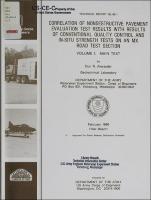Please use this identifier to cite or link to this item:
https://hdl.handle.net/11681/12744| Title: | Correlation of nondestructive pavement evaluation test results with results of conventional quality control and in-situ strength tests on an MX road test section, volume 1 : main text |
| Authors: | Alexander, Don R. |
| Keywords: | Nondestructive testing NDT Roads Pavements Soils Testing Tests |
| Publisher: | Geotechnical Laboratory (U.S.) Engineer Research and Development Center (U.S.) |
| Series/Report no.: | Technical report (U.S. Army Engineer Waterways Experiment Station) ; GL-86-1. |
| Description: | Technical Report Abstract: An investigation vas performed to develop and study relationships betveen nondestructive test (NDT) results and various pavement parameters such as layer thickness, density, and strength. The use or NDT devices bas proven viable for evaluation of conventionally designed rigid and flexible pavements and is seen aa a great advance over costly and time-consuming destructive evaluation techniques. These same principles can perhaps be effectively applied to include the evaluation of in-situ soil conditions, unsurfaced design or design verification, and construction quality control. Data for this study were obtained during the construction and traffic testing of a test section built tor the purpose of obtaining data to validate and possibly reduce present criteria or develop new criteria for design of roads subjected to the heavy wheel loads associated with a proposed MX Missile transporter. The test section measured 250 ft long by 50 ft wide by 6 ft deep and consisted of three traffic lanes with five items per lane. Materials used in constructing the test section included limestone, buckshot clay, silt, Blend I, and Blend II . The blended soils were put together at the Waterways Experiment Station (WES) to simulate gradations anticipated in the proposed construction area. Types of surfacing included unsurfaced blended soils, crushed limestone and silt, cement-stabilized blended soils, lean mix concrete batched from blended soil, and single- and double-bituminous surface treatments. Soil instrumentation was provided in three items for measurement of vertical deflection, vertical stress, and pore pressures. Nondestructive tests were performed during construction and traffic with the WES 16-kip vibrator, a Dynatest falling weight deflectometer, and a Road Rater 2008. The teat section was trafficked with a two-wheel (single tandem) load cart representing two axles of the transporter. A total of 2,600 load cart passes were applied to each lane. Due to inherent limitations of the data set, results of this study were inconclusive with respect to the feasibility of NDT for pavement construction quality control and design verification. However, some useful direct comparisons between NDT results and conventional test parameters were obtained. A brief summary of the significant findings is as follows: A.) Dynamic stiffness modulus (DSM) versus thickness relationships can be determined for any soil type, and a limiting stiffness for each material does exist. Once sufficient thickness has been added to achieve this limiting value, no change in DSM can be realited by further addition of the same quality material. B.) DSM , although a function of thickness as well as strength, is a potentially good indicator of inplace strength with respect to performance; it is perhaps better than the conventional California Bearing Ratio (CBR) test. C.) Good correlation vas observed between in-place density and surface DSM, layer thickness, and subgrade DSM. D.) Efforts to directly correlate RDT test results to the conventional strength parameters of CBR and k were relatively unsuccessful . E) It was determined statistically that high levels of confidence can be achieved for the 16-kip vibrator and falling weight deflectometer test results by performing a reasonable number of tests. F.) Modulus values computed using the layered elastic computer program BISDEF and WES 16-kip vibrator deflection data appeared reasonable for subsurface layers and surface layers greater than about 15 in. thick and compared relatlvely well with laboratory resilient modulus test results. G.) Favorable comparison was observed between vertical displacements measured by linear variable differential transformer gages installed in the test section and deflections predicted using layered elastic theory (computer programs BISAR and BISDEF) and falling weight deflectometer surface deflection data. H.) It was not determined how or to what extent NDT test results would be affected by the approach of failure, and very lit tle per formance data were gained since traffic on the test section was stopped after 2,600 passes. I.) Relatively good correlation was found to exist between 16-kip and falling weight deflectometer DSM's. |
| Rights: | Approved for public release; distribution is unlimited. |
| URI: | http://hdl.handle.net/11681/12744 |
| Appears in Collections: | Technical Report |
Files in This Item:
| File | Description | Size | Format | |
|---|---|---|---|---|
| TR-GL-86-1-V1.pdf | 12.86 MB | Adobe PDF |  View/Open |